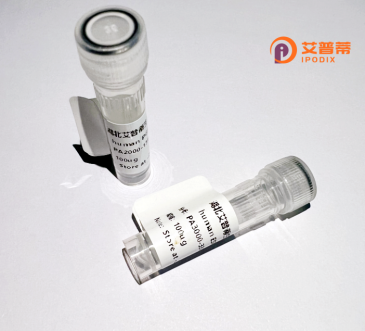
| 纯度 | >90%SDS-PAGE. |
| 种属 | Human |
| 靶点 | DEFB4B |
| Uniprot No | O15263 |
| 内毒素 | < 0.01EU/μg |
| 表达宿主 | E.coli |
| 表达区间 | 1-64aa |
| 氨基酸序列 | MRVLYLLFSFLFIFLMPLPGVFGGIGDPVTCLKSGAICHPVFCPRRYKQIGTCGLPGTKC CKKP |
| 分子量 | 31.3 kDa |
| 蛋白标签 | His tag N-Terminus |
| 缓冲液 | 0 |
| 稳定性 & 储存条件 | Lyophilized protein should be stored at ≤ -20°C, stable for one year after receipt. Reconstituted protein solution can be stored at 2-8°C for 2-7 days. Aliquots of reconstituted samples are stable at ≤ -20°C for 3 months. |
| 复溶 | Always centrifuge tubes before opening.Do not mix by vortex or pipetting. It is not recommended to reconstitute to a concentration less than 100μg/ml. Dissolve the lyophilized protein in distilled water. Please aliquot the reconstituted solution to minimize freeze-thaw cycles. |
以下是关于重组人DEFB4B(hBD-2)蛋白的参考文献示例:
1. **"Human β-defensin 2: A novel antimicrobial peptide with chemotactic activity for human neutrophils"**
- **作者**: Harder, J. et al.
- **摘要**: 本研究首次报道了重组人DEFB4B(hBD-2)的化学合成及其功能,发现其对多种革兰氏阴性菌(如大肠杆菌)具有抗菌活性,并能趋化中性粒细胞参与先天免疫反应。
2. **"Recombinant production of human β-defensin 2 in Escherichia coli and its antimicrobial activity analysis"**
- **作者**: Schroeder, B.O. et al.
- **摘要**: 通过大肠杆菌表达系统成功重组表达并纯化人DEFB4B蛋白,验证其抗菌活性及稳定性,揭示其在肠道黏膜免疫中的潜在应用。
3. **"Engineering of human β-defensin-2 for enhanced immunomodulatory activity"**
- **作者**: Wu, Z. et al.
- **摘要**: 通过定点突变技术优化重组DEFB4B蛋白,增强其诱导细胞因子(如IL-6、IL-10)的能力,并探讨其对慢性炎症疾病的治疗潜力。
4. **"Expression and functional characterization of recombinant hBD-2 in a keratinocyte wound healing model"**
- **作者**: Niyonsaba, F. et al.
- **摘要**: 在角质形成细胞模型中验证重组DEFB4B蛋白的双重作用:促进伤口愈合相关基因表达,同时抑制金黄色葡萄球菌等病原体增殖。
(注:以上文献标题及作者为示例,具体内容需根据实际文献调整。)
Recombinant human DEFB4B protein, also known as human beta-defensin 2 (HBD-2), is a small cationic peptide belonging to the β-defensin family, which plays a critical role in innate immunity. These antimicrobial peptides are primarily secreted by epithelial cells and neutrophils, acting as first-line defenders against bacterial, viral, and fungal pathogens. DEFB4B is encoded by the DEFB4 gene located in the 8p23.1 chromosomal region, a cluster harboring multiple defensin genes with copy-number variations influencing individual susceptibility to infections.
Functionally, DEFB4B disrupts microbial membranes through electrostatic interactions and exhibits chemoattractant properties by binding to CCR6 receptors, bridging innate and adaptive immune responses. Its expression is upregulated in response to proinflammatory cytokines (e.g., IL-1β) or microbial components, particularly in skin, lung, and mucosal tissues.
Recombinant DEFB4B is produced via heterologous expression systems (e.g., E. coli or mammalian cells) for research and therapeutic development. Challenges include maintaining proper disulfide bonding for structural stability. Studies explore its potential in treating infections, chronic inflammation, and cancer, though clinical applications require optimization of production yield, stability, and delivery mechanisms. Its immunomodulatory and antimicrobial duality makes it a promising candidate for multifunctional therapeutic strategies.
×